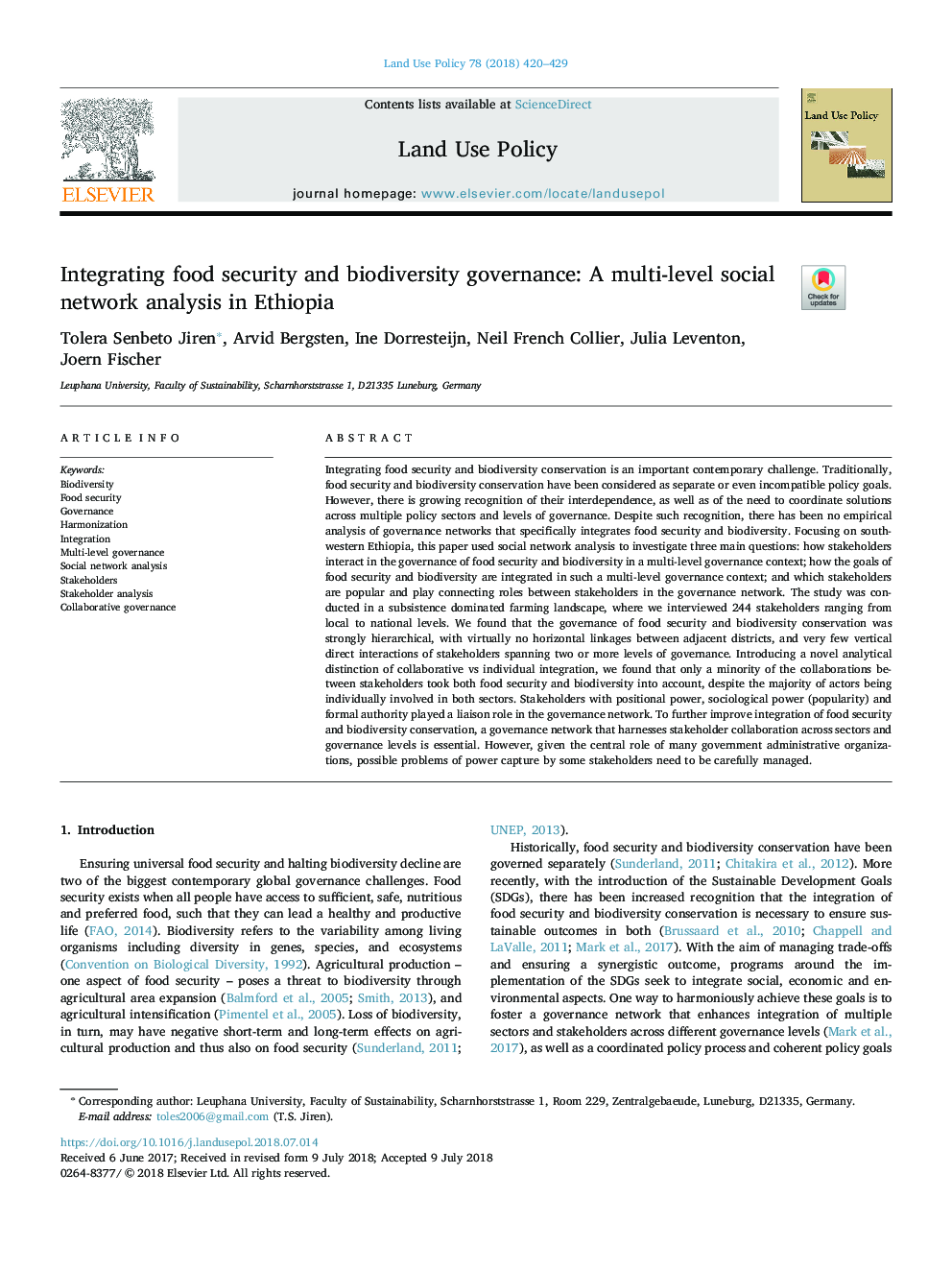| کد مقاله | کد نشریه | سال انتشار | مقاله انگلیسی | نسخه تمام متن |
|---|---|---|---|---|
| 6546052 | 1421805 | 2018 | 10 صفحه PDF | دانلود رایگان |
عنوان انگلیسی مقاله ISI
Integrating food security and biodiversity governance: A multi-level social network analysis in Ethiopia
ترجمه فارسی عنوان
ادغام امنیت غذایی و مدیریت تنوع زیستی: تجزیه و تحلیل شبکه های چند سطحی در اتیوپی
دانلود مقاله + سفارش ترجمه
دانلود مقاله ISI انگلیسی
رایگان برای ایرانیان
کلمات کلیدی
تنوع زیستی، امنیت غذایی، حکومت، هماهنگی، ادغام، حکومت چندسطحی، تجزیه و تحلیل شبکه شبکه، سهامداران، تجزیه و تحلیل متقابل، حکمرانی همکاری،
Integration - ادغامFood security - امنیت غذاییStakeholder analysis - تجزیه و تحلیل متقابلSocial network analysis - تحلیل شبکه های اجتماعیBiodiversity - تنوع زیستیGovernance - حکومتCollaborative governance - حکومت همکاریMulti-level governance - حکومت چند سطحیStakeholders - سهامدارانHarmonization - هماهنگی
ترجمه چکیده
یکپارچه سازی امنیت غذایی و حفاظت از تنوع زیستی یک چالش معاصر مهم است. به طور سنتی امنیت غذایی و حفاظت از تنوع زیستی به عنوان اهداف سیاست جداگانه یا حتی ناسازگار در نظر گرفته شده است. با این حال، در حال افزایش به رسمیت شناختن وابستگی متقابل آنها، و همچنین نیاز به هماهنگی راه حل ها در بخش های مختلف سیاست و سطوح حکومت. با وجود چنین شناختی، هیچ تحلیلی تجربی از شبکه های حکومتی وجود ندارد که به طور خاص امنیت غذایی و تنوع زیستی را ادغام کند. با تمرکز بر جنوب غربی اتیوپی، این مقاله از تحلیل شبکه های اجتماعی برای بررسی سه پرسش اصلی استفاده می کند: چگونه ذینفعان در مدیریت امنیت غذایی و تنوع زیستی در یک زمینه حکومتداری چند سطحی موثرند؛ چگونه اهداف امنیت غذایی و تنوع زیستی در یک چارچوب حاکمیت چند سطحی یکپارچه شده است؟ و کدام سهامداران محبوب هستند و نقش های متفاوتی را در بین سهامداران در شبکه حکومتی ایفا می کنند. این مطالعه در چشم انداز کشاورزی تحت تأثیر قرار گرفت که در آن 244 ذینفع از سطح محلی تا ملی مورد مصاحبه قرار گرفتند. ما دریافتیم که مدیریت امنیت غذایی و حفاظت از تنوع زیستی به شدت سلسله مراتبی است و تقریبا هیچ ارتباط افقی میان نواحی مجاور و چندین تعامل مستقیم عمیق ذینفعان با دو یا چند سطح حکومتداری وجود ندارد. معرفی یک تمایز تحلیلی جدید از همکاری در مقابل ادغام فردی، ما دریافتیم که تنها یک اقلیت از همکاری بین ذینفعان در هر دو مورد امنیت غذایی و تنوع زیستی را در نظر گرفته، با وجود اکثر بازیگران که به طور جداگانه در هر دو بخش دخیل هستند. مشارکت کنندگان با قدرت موضعی، قدرت جامعه شناختی (محبوبیت) و قدرت رسمی نقش حائز اهمیت در شبکه حکومتی داشتند. برای بهبود ادغام امنیت غذایی و حفاظت از تنوع زیستی، یک شبکه حکومتی که بهره وری مشارکت کنندگان را در سراسر بخش ها و سطوح حکومتی به کار می گیرد ضروری است. با این حال، با توجه به نقش مرکزی بسیاری از سازمان های اداری دولتی، ممکن است مشکلات احتمالی ضبط قدرت توسط برخی از سهامداران با دقت مدیریت شود.
موضوعات مرتبط
علوم زیستی و بیوفناوری
علوم کشاورزی و بیولوژیک
جنگلداری
چکیده انگلیسی
Integrating food security and biodiversity conservation is an important contemporary challenge. Traditionally, food security and biodiversity conservation have been considered as separate or even incompatible policy goals. However, there is growing recognition of their interdependence, as well as of the need to coordinate solutions across multiple policy sectors and levels of governance. Despite such recognition, there has been no empirical analysis of governance networks that specifically integrates food security and biodiversity. Focusing on southwestern Ethiopia, this paper used social network analysis to investigate three main questions: how stakeholders interact in the governance of food security and biodiversity in a multi-level governance context; how the goals of food security and biodiversity are integrated in such a multi-level governance context; and which stakeholders are popular and play connecting roles between stakeholders in the governance network. The study was conducted in a subsistence dominated farming landscape, where we interviewed 244 stakeholders ranging from local to national levels. We found that the governance of food security and biodiversity conservation was strongly hierarchical, with virtually no horizontal linkages between adjacent districts, and very few vertical direct interactions of stakeholders spanning two or more levels of governance. Introducing a novel analytical distinction of collaborative vs individual integration, we found that only a minority of the collaborations between stakeholders took both food security and biodiversity into account, despite the majority of actors being individually involved in both sectors. Stakeholders with positional power, sociological power (popularity) and formal authority played a liaison role in the governance network. To further improve integration of food security and biodiversity conservation, a governance network that harnesses stakeholder collaboration across sectors and governance levels is essential. However, given the central role of many government administrative organizations, possible problems of power capture by some stakeholders need to be carefully managed.
ناشر
Database: Elsevier - ScienceDirect (ساینس دایرکت)
Journal: Land Use Policy - Volume 78, November 2018, Pages 420-429
Journal: Land Use Policy - Volume 78, November 2018, Pages 420-429
نویسندگان
Tolera Senbeto Jiren, Arvid Bergsten, Ine Dorresteijn, Neil French Collier, Julia Leventon, Joern Fischer,
